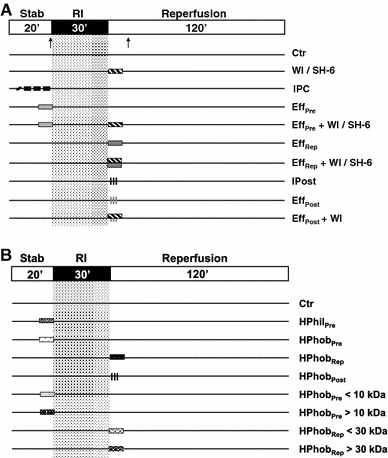Fig. 1.

Experimental protocols. All groups were subjected to 30 min of regional ischemia (RI) followed by 120 min of reperfusion. Hearts receiving no other treatments constitute the control group (Ctr). a The IPC group was exposed to 3× 5 min global ischemia (GI), with 5 min intermittent reperfusion periods prior to RI. To test the temporal cytoprotective efficacy of IPC effluent in recipient hearts, freshly collected effluent was administered for 10 min prior to RI (EffPre) or for 10 min at onset of ischemic reperfusion (EffRep). Furthermore, to mimic ischemic postconditioning, the IPC effluent was administered for 3× 30 s with 30 s intermittent KHB perfusion at immediate reperfusion (EffPost). Ischemic postconditioning (IPost) was achieved by 3× 30 s of global ischemia (GI) at early ischemic reperfusion. The PI3K-inhibitor WI (1 μM) and the Akt-inhibitor SH-6 (10 μM) were administered for 10 min at immediate onset of ischemic reperfusion in conjunction with 10 min of pre- or post-ischemic treatment with IPC effluent (EffPre + WI/SH-6, EffRep + WI/SH-6 or EffPost + WI). b The IPC effluent was fractionated in respect to charge and size. Effluent collected during IPC was first separated into a hydrophilic (HPhil) and a hydrophobic (HPhob) fraction. All total effluent fractions were administered for either 10 min prior to ischemia (HPhilPre and HPhobPre) or for 10 min at reperfusion (HPhobRep and HPhobPost). The hydrophobic fraction was further fractionated by a 10 or 30 kDa size filter resulting in four hydrophobic fractions with molecules below 10/30 kDa (HPhobPre < 10 and HPhobRep < 30) or above 10/30 kDa (HPhobPre > 10 and HPhobRep > 30). Arrows indicate time points for tissue sampling. Solid lines KH buffer perfusion
